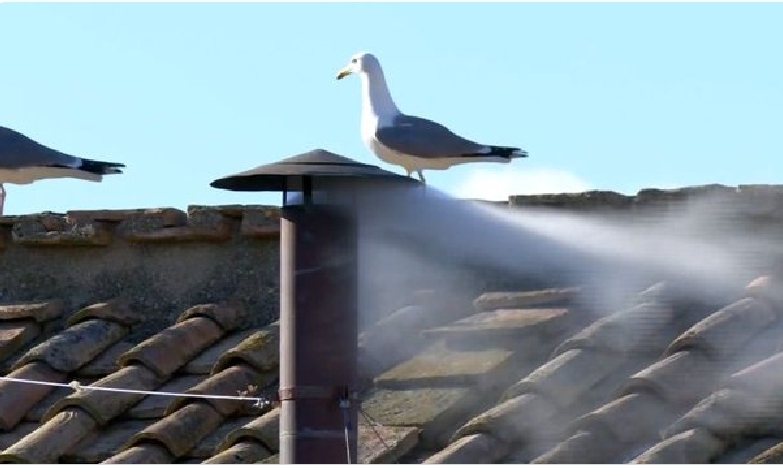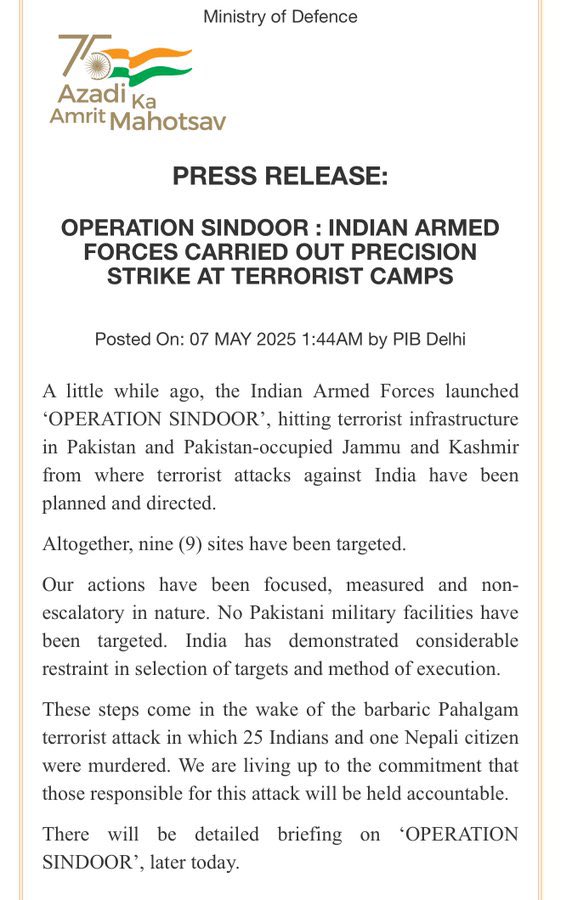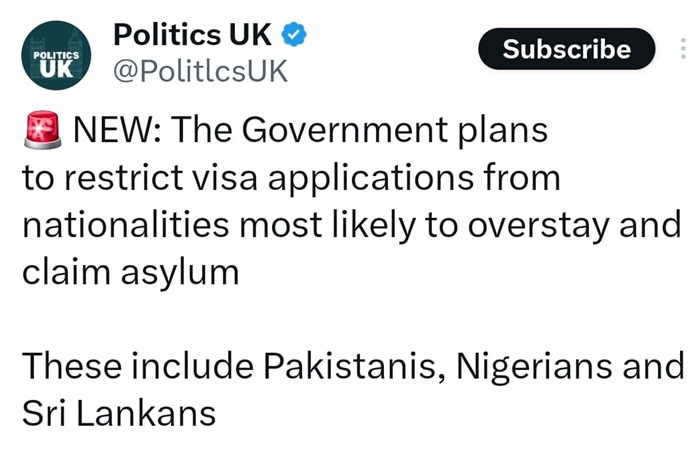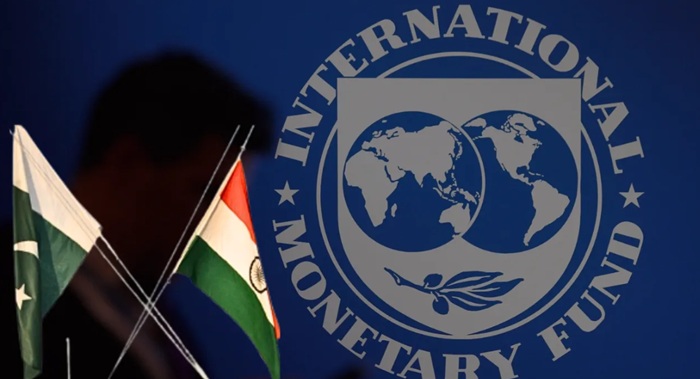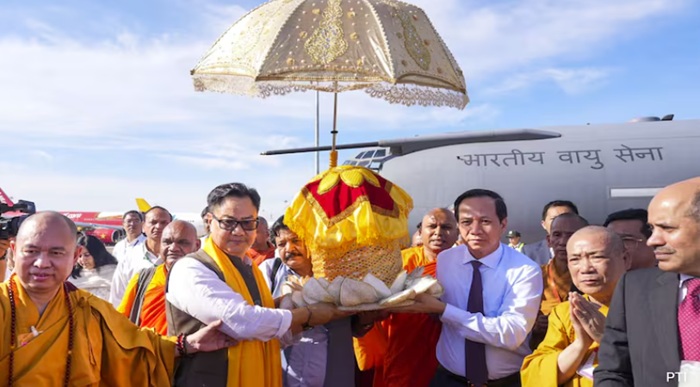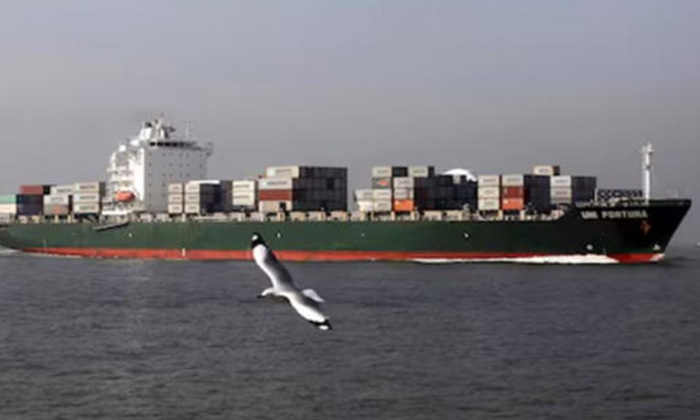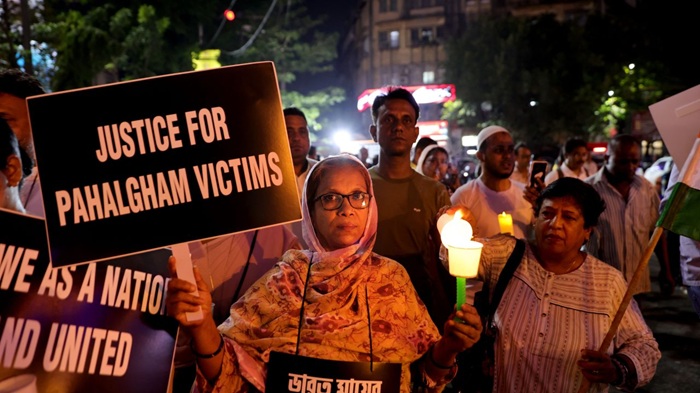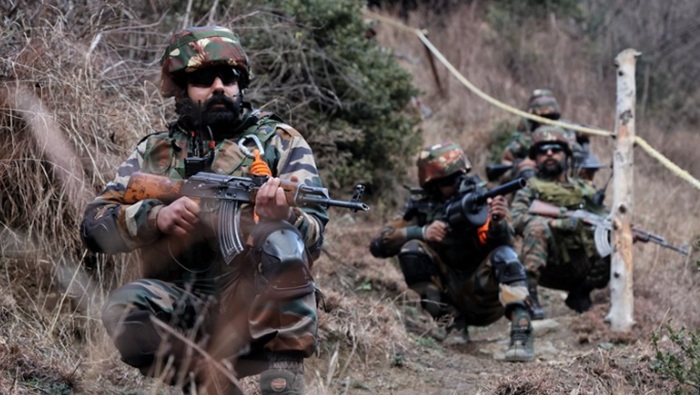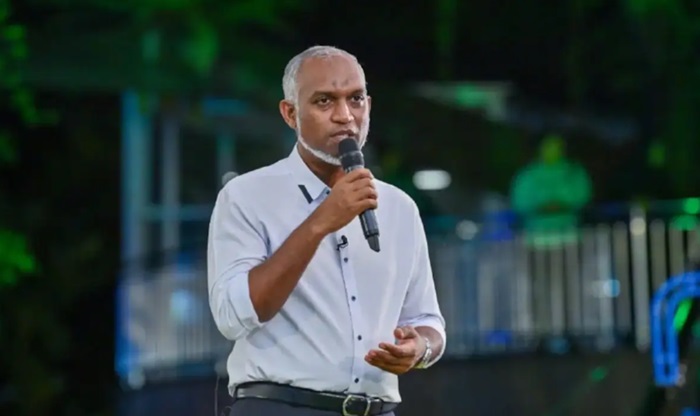The Pakistan Cricket Board (PCB) announces the postponement of the remaining eight matches of the HBL PSL X. The last 24 hours have seen a worsening of the situation on the LOC, increased incursion of 78 drones, and the firing of surface to surface missiles from India. The decision to postpone has been taken pursuant to advice received from the Prime Minister Mian Muhammad Shahbaz Sharif who has kept in view the reckless aggression from India that has escalated to a point where national attention and sentiments are rightly focused on the courageous efforts of the Armed Forces of Pakistan who are vociferously upholding the sovereignty of our beloved Pakistan. The PCB and its players stand resolutely in solidarity with the families of the martyrs and our security personnel defending the nation. The PCB recognizes the efforts and support of its partners, franchises, participating players, broadcasters, sponsors, and organizers in having ensured the smooth conduct of the tournament thus far, however; cricket while being a unifying force and a source of joy, must take a respectful pause when the country is facing such callous opposition. We, at the PCB, also have sincere regard for the mental well-being of participating players and the sentiments of our foreign players, and we respect the concerns of their families who want to see them back home. The post India- Pakistan issue : PSL postponed appeared first on Newswire. | ↑ |
White smoke appeared from a chimney atop the Sistine Chapel at the Vatican, signaling that the 133 Roman Catholic cardinals Continue Reading The post White smoke emerges at the Vatican as a new pope is elected appeared first on Newswire. | ↑ |
Black smoke rose from the chimney over the Sistine Chapel at 11:50 on Thursday morning, signalling the second ballot of the first full day of the conclave – and the third ballot overall – was inconclusive. As the cardinals break for lunch, the people in the square continue to look up at the chimney in anticipation. Voting is expected to resume at around 16:00. Around 15,000 people had gathered in St Peter’s Square to await the announcement. (Vatican News) The post Cardinals signal with Black smoke again : No new Pope yet appeared first on Newswire. | ↑ |
Pakistan attempts late last night and early this morning to escalate tension with India by targeting military installations in 15 cities in the northern and western parts of the country – including Jammu and Kashmir, Punjab, and Gujarat – have been negated, the Indian government said Thursday. The government said Indian forces responded by targeting and neutralising Pakistani Air Defence Radars and systems in several locations, including Lahore, in response to Pak attempts to attack military facilities in Srinagar, Pathankot, Amritsar, Ludhiana, Chandigarh, and other locations. Indian forces’ response, the government underlined this afternoon, was “in the same domain (and) with the same intensity” as the attacks launched by Pakistan. Pak forces used drones and missiles that were disabled by India’s air defence systems. Sources told news agency ANI HARPY drones were used by India to destroy Pak air defences, while India then used the Russian-made S-400 defence system to shoot down missiles aimed at its cities. (NDTV) The post India says neutralised Pakistan missiles aimed at 15 cities appeared first on Newswire. | ↑ |
The Indian army said its soldiers exchanged fire with the Pakistani army overnight along the de facto border in Kashmir. Small arms and artillery fire were both in use. This comes as the two neighboring countries saw their worst violence in two decades after India launched missile strikes on Pakistan. At least 43 deaths have been reported by both countries since the military escalation between them on Wednesday, with Islamabad saying that 31 civilians had been killed by India’s missiles and New Delhi reporting 13 casualties. Meanwhile, Pakistan said it shot down 12 drones shot by India overnight, with one civilian being killed and multiple soldiers being wounded as a result of one of the drones. According to Pakistan’s military spokesman Ahmed Sharif Chaudhry, the attack was “another act of aggression” by India. The country’s civil aviation authority said three of the country’s airports will remain closed until 18:00 local time (1300 GMT). That included the airport for the Pakistani capital, Islamabad. The airports in Karachi and Lahore will also be shut until the early evening. (DW) The post Kashmir updates : India & Pakistan exchange fire overnight appeared first on Newswire. | ↑ |
Pakistan’s military said on Thursday that it shot down 12 drones sent by India in an alleged violation of its airspace, a day after Indian airstrikes targeted multiple locations inside Pakistan, raising fears of a wider conflict between the two nuclear-armed nations, Reuters reported. According to military spokesperson Major General Ahmed Sharif Chaudhry, the Indian drones—identified as Israeli-made Harop drones—were intercepted at various sites, including near Pakistan’s two largest cities, Karachi and Lahore. He said debris from the drones is currently being collected. “Indian drones continue to be sent into Pakistan airspace… (India) will continue to pay dearly for this naked aggression,” Chaudhry warned at a media briefing. The Pakistan military reported that the drone operations resulted in the death of one civilian and injuries to four soldiers. One of the drones reportedly hit a military target near Lahore. India’s defence ministry has not yet responded to the latest allegations. The developments come amid heightened tensions following Indian strikes on Wednesday that Pakistan described as targeting six locations across its territory. (Newswire) The post Pakistan claims 12 Indian Drones shot down, including one near Lahore appeared first on Newswire. | ↑ |
In a note to correspondents issued by his spokesperson on Tuesday, United Nations (UN) Secretary-General Antonio Guterres called for military restraint from India and Pakistan. “The world cannot afford a military confrontation between India and Pakistan,” the note said. On Monday, the Secretary-General had warned that the tensions between the two South Asian neighbours had reached “their highest in years.” He offered his good offices to both governments to help defuse tensions and promote diplomacy, stressing that “a military solution is no solution.” Speaking to the media on Monday, Guterres condemned the 22 April terror attack in the Pahalgam area of Jammu and Kashmir, which left at least 26 civilians dead and many more injured. “Targeting civilians is unacceptable – and those responsible must be brought to justice through credible and lawful means,” he said. (UN) The post UN Secretary-General urges military restraint from India, Pakistan appeared first on Newswire. | ↑ |
India’s Defence Ministry says the Indian Armed Forces launched ‘Operation Sindoor’, hitting nine sites of terrorist infrastructure in Pakistan and Pakistan-occupied Jammu and Kashmir from where terrorist attacks against India have been planned and directed. (Newswire)
The post India launches ‘MISSILE ATTACK’ on Pakistan appeared first on Newswire. | ↑ |
India’s Ministry of Culture has initiated measures to halt the auction of Piprahwa relics, linked to Lord Buddha, scheduled by Sotheby’s Hong Kong. The artifacts, excavated in 1898 from the Piprahwa Stupa in Uttar Pradesh, include bone fragments and caskets. The site is closely associated with Buddha’s early life. Classified as ‘AA’ antiquities under Indian law, the relics are prohibited from sale or export. While some were transferred to the Indian Museum, Kolkata, in 1899, a portion retained by the family of British excavator William Claxton Peppe has been listed for auction. The ministry issued a legal notice to Sotheby’s and directed the Archaeological Survey of India (ASI) to request intervention via Hong Kong’s Consulate General. During a bilateral meeting with UK Culture Secretary Lisa Nandy on May 2, Culture Minister Gajendra Singh Shekhawat emphasised the relics’ significance and sought repatriation efforts. A high-level meeting on May 5 outlined further steps, including engagement by the Ministry of External Affairs with embassies in the UK and Hong Kong. The Financial Investigation Unit (FIU) will collaborate with Hong Kong authorities to enforce international laws. The Indian government issued a detailed legal notice to Sotheby’s Hong Kong and Chris Peppe, descendant of British colonial excavator William Claxton Peppe. The Ministry of Culture called the sale a “violation of Indian law, international conventions, and the sanctity of Buddhist heritage,” demanding immediate cancellation and repatriation. The notice asserts the relics are “inalienable religious and cultural heritage” protected under India’s Antiquities and Art Treasures Act (1972), which designates them as ‘AA’-grade antiquities. It clarifies that while some relics were transferred to Kolkata’s Indian Museum in 1899 and others gifted to the King of Siam, the Peppe family retained items erroneously labeled as “duplicate jewels” under temporary custodianship. “The term ‘duplicate’ is historically and religiously inaccurate,” the notice reads, citing Brahmi inscriptions confirming the relics were interred by the Sakya clan as offerings to the Buddha. “These sacred grave goods are inseparable from the Buddha’s remains. To commodify them violates Buddhist theology and international ethical norms.” Challenging Sotheby’s description of the Peppe family as “custodians,” the notice states, “Custodianship does not grant rights to alienate or misappropriate assets. The relics belong to the Buddha, the Sakya clan, and India, where the stupa stands.” It references a 2004 Sunday Times report revealing the relics were “forgotten in a shoebox at the bottom of a cabinet,” countering claims of reverent preservation. “Monetizing custodianship through publicity and exhibition contradicts the sacred responsibility entrusted to custodians,” the notice adds. Under Indian law, the relics are classified as state property under the Ancient Monuments Act (1958) and the Treasure Trove Act (1878), which vested ownership with the colonial government at the time of excavation. “Mr. Peppe was granted temporary custody, not ownership. India’s post-independence laws affirm the state’s sole rights over such antiquities,” the notice states. Internationally, it invokes the UNESCO 1970 Convention (ratified by India and China/Hong Kong) and the UNIDROIT 1995 Convention, which mandate the return of illegally exported cultural property. “No legal export documentation exists for these relics. Their sale contravenes Article 3 of UNIDROIT, requiring repatriation of illicitly removed artifacts,” it adds. The ministry cites precedents, including the 1952 return of Sanchi Stupa relics from the UK’s Victoria & Albert Museum and the ongoing repatriation of Benin Bronzes to Nigeria, to underscore a “global ethical shift” against colonial-era acquisitions. “Just as the Benin Bronzes symbolize the suffering of the Edo people, these relics represent the spiritual legacy of millions of Buddhists. Their sale perpetuates colonial injustice,” the notice argues. Highlighting religious sensitivities, the document quotes the International Council of Museums (ICOM) Code of Ethics, which requires museums to handle sacred materials “in a manner consistent with the beliefs of their communities of origin.” It condemns the auction as “an affront to 500 million Buddhists,” noting objections from groups like the British Maha Bodhi Society. “The Buddha’s relics are not art market commodities but objects of veneration. Their sale desecrates a global spiritual legacy,” the notice states. Ethical concerns are amplified by comparisons to halted auctions, such as Sotheby’s 2019 withdrawal of an Egyptian artifact after looting claims and the 2024 Graceland Auction controversy. “Auction houses have a duty to avoid profiting from contested heritage,” the notice says, accusing Sotheby’s of “condoning grave robbery and colonial exploitation.” India demands Sotheby’s immediately cancel the auction, repatriate the relics through diplomatic channels, issue a public apology, and disclose all provenance documents and details of relics held by the Peppe family. Non-compliance risks “legal action in Indian and Hong Kong courts, UNESCO interventions, and global advocacy campaigns exposing Sotheby’s role in cultural commodification.” The Ministry expressed openness to negotiations but warned, “The relics’ sanctity cannot be bargained. Their return is non-negotiable.” Sotheby’s Associate General Counsel Ivy Wong acknowledged the notice, stating, “Full attention is given to this matter.” The auction remains scheduled for Wednesday at 10:30am in Hong Kong. (Hindustan Times) The post India moves to block auction of Buddha relics in Hong Kong appeared first on Newswire. | ↑ |
The UK’s Home Office will restrict work and study visa applications from nationalities including Sri Lankans, Pakistanis, and Nigerians, who are most likely to overstay and claim asylum. Under Labour’s plans to crack down on abuse of the system, visas will be rejected for individuals who fit the profile of someone who will go on to claim asylum and are from countries with high rates of asylum claims in the UK. Officials will also use bank statements submitted by visa applicants to reject claims that they are destitute and require taxpayer-funded accommodation, such as hotels. It is understood that the measures will be announced as part of efforts to prevent work and study visas from being used as a backdoor into Britain’s asylum system. They will be part of the government’s Immigration White Paper, due to be published next week, that will detail Sir Keir Starmer’s plan for reducing net migration, which stood at 728,000 last year. The curbs are likely to prompt a backlash from those countries included, who may feel it discriminates against them. Legal sources said the move would be discriminatory and would be challenged in the courts. Immigration reforms were promised in Labour’s general election manifesto last year but have taken on added impetus after the party was trounced by Nigel Farage’s Reform in last week’s local elections. Other reforms expected include restrictions that will force foreign graduates to leave the UK unless they get a graduate-level job, which will be based on skill levels rather than salary. Being granted asylum gives individuals the opportunity to stay in the UK permanently, whereas work and study visas are only temporary. Rejected asylum seekers can prolong their stay — sometimes indefinitely — by making repeated appeals to frustrate their deportation. Yvette Cooper, the Home Secretary, is concerned about a sharp increase in migrants on work and study visas who go on to claim asylum and are housed in Home Office-provided accommodation. Last year, 40,000 asylum claims were lodged by people who had held a UK visa, 37 per cent of the total and more than the 35,000 asylum applications from migrants who arrived on small boats. Nearly 10,000 asylum claimants who had originally arrived in the UK legally on work or study visas were living in taxpayer-funded accommodation, such as hotels, at some point last year. Cooper is planning to introduce measures to bar migrants who came to the UK on a work or study visa from claiming taxpayer-funded accommodation. Asylum seekers can claim accommodation and other financial support if they are destitute or likely to become destitute. However, work and study visa holders must prove they have sufficient funds to sustain themselves while in the UK. Officials will be instructed to use the bank statements submitted by visa holders as part of their assessment when deciding whether to grant them asylum accommodation. This will make it significantly harder for asylum seekers to claim free accommodation if they came to the UK on a visa. The Home Office is also building intelligence to enable caseworkers to spot patterns in the profile of people who are most likely to abuse work and study visas as a loophole to claim asylum. They have earmarked Pakistani, Nigerian and Sri Lankan visa holders as the most likely to go on to apply for asylum, according to government sources. Officials are working with the National Crime Agency (NCA) to build a model that would reject a visa claim from a migrant who fits the profile of someone likely to go on to claim asylum. They have identified patterns of behaviour, such as low engagement in university courses, of individuals who have used the routes to claim asylum. The Home Office and NCA will also investigate interactions of visa applicants from countries with high rates of asylum claims to check whether they have been in contact with suspected people smugglers or individuals who teach migrants how to use the UK’s visa system as a back door to claiming asylum. Of the 40,000 asylum claims lodged last year by people who had held a UK visa, 16,000 were originally foreign students, 11,500 had a work visa, 9,500 had a visitor visa, and the remaining 7 per cent had other forms of leave. Asylum seekers can also claim protection for family members who are with them. There has been a surge in the number of migrants on study and work visas bringing dependents in the last three years, with Indians and Nigerians the most likely to do so. (The Times)
The post Sri Lankans among nationalities in UK’s visa crackdown appeared first on Newswire. | ↑ |
India has opened a multi-dimensional front against Pakistan in the aftermath of the horrific terror attack in Pahalgam and is strategically planning twin financial strikes on Islamabad to throttle support for cross-border terrorism. As per sources. India is initiating steps to actively pursue getting Pakistan back onto the Financial Action Task Force (FATF) grey list. Besides, India has also raised concerns with the International Monetary Fund over its $7 billion aid package to Pakistan, alleging misuse of funds for terror-related activities. The deal for the three-year aid package was finalised in July 2024. India has asked the IMF to review loans disbursed to Pakistan, said a Reuters report on Friday, citing an Indian government source. Pakistan secured a $7 billion bailout programme from the IMF last year and was granted a new $1.3 billion climate resilience loan in March. The programme is critical for Pakistan, which said it has stabilised under the bailout that helped it stave off a default threat. The IMF Executive Board will meet on May 9 to discuss Pakistan’s staff-level agreement for a new arrangement, along with the first review of Pakistan’s ongoing bailout programme, the global lender said earlier this week. Reacting to the reports, Khurram Shehzad, adviser to Pakistan’s finance minister told Dawn on Friday that the country’s IMF programme was “completely on track”. He said that they conducted “very productive meetings” with the IMF, World Bank, the Asian Development Bank and other International Financial Institutions. “While in the spring meetings in DC, we did about 70 meetings within (a) span of six days,” he said. Pakistan was put on the ‘grey list’ of the global money laundering and terror financing watchdog in June 2018. Islamabad was taken off the list in October 2022 after it committed to curbing terror funding and it jailed, fined, and confiscated assets of individuals linked to terror groups. If reinstated, the FATF grey list status will increase scrutiny on Pakistan’s financial dealings, potentially restricting foreign investments and capital inflows into the country. India is likely to engage with key FATF member states in the coming weeks to garner support for its move ahead of the next plenary session. The plenary is the decision-making body of the FATF, which consists of 40 member states. The plenary usually meets thrice a year, in February, June, and October. India has already taken a host of punitive measures against Pakistan following the Pahalgam terror attack that left 25 tourists and a local dead. Apart from downgrading diplomatic relations with Pakistan, India has suspended the Indus Waters Treaty, closed the Integrated Check Post at the Attari-Wagah border, cancelled visa services for Pakistani nationals and closed its airspace to Pakistani flights. The Centre has also banned 16 Pakistani YouTube channels and blocked the Instagram accounts of several Pakistanis. (WION) The post India plots double financial strike on Pakistan to stifle terror funding, jittery Islamabad reacts appeared first on Newswire. | ↑ |
This remarkable feat is not just a number; it signifies a deep and transformative shift in India’s economic and innovation landscape. Over the past decade, India has been laying the foundation for a thriving startup environment. Today, that vision stands validated. From technology and healthcare to green energy and space research, Indian startups are leaving a distinctive mark on the global stage. The surge in innovation and patent filings further underscores the depth and originality of the ideas emerging from India’s vibrant entrepreneurial community. A decade of determination The journey to this point has been nothing short of inspiring. Government initiatives like Startup India, Atal Innovation Mission, and Make in India played a crucial role in creating an ecosystem where ideas could blossom into sustainable enterprises. Strategic policy frameworks, coupled with increasing private sector enthusiasm, built an environment ripe for innovation. Minister Singh rightly highlighted the “significant gains” made not just in the quantity, but the quality of innovation. In recent years, India has witnessed a dramatic uptick in patent filings, a clear indication that startups are not just replicating global trends but are pioneering original ideas. According to official data, patent registrations by Indian entities have more than doubled over the past five years — a testimony to the maturing innovation landscape. The innovation economy Innovation has now become the cornerstone of India’s economic growth story. Areas like artificial intelligence, biotechnology, green hydrogen, fintech, and space technology are witnessing explosive growth, driven largely by nimble startups hungry to solve complex problems. Cities like Bengaluru, Hyderabad, Pune, and Gurugram have turned into global hubs of creativity, teeming with startupsthat are redefining how the world views Indian entrepreneurship. Meanwhile, tier-II and tier-III cities are increasingly emerging as the new frontiers of startup activity, thanks to enhanced digital connectivity, localised incubators, and robust mentorship networks. This democratisation of innovation across the country ensures that India’s growth story is truly inclusive, bringing opportunities to every corner of the nation. Powering the patent boom A noteworthy trend accompanying the startup surge has been India’s rise in patent filings. Filing a patent is more than a bureaucratic process; it reflects a culture that values intellectual property, originality, and long-term investment in research and development. Indian startups are now increasingly embedding R&D into their core DNA, moving beyond a service-provider mindset to a product-first, innovation-led approach. Whether it’s developing indigenous drone technologies, crafting world-class SaaS platforms, or advancing solutions in renewable energy, startups are setting global benchmarks. Government efforts such as simplifying patent application processes, reducing fees for startups, and raising awareness about intellectual property rights have paid rich dividends. Institutions like the Indian Patent Office have also modernised to keep pace with the volume and sophistication of filings, making India an even more attractive destination for innovation-driven enterprises. A magnet for global investment India’s third-place global ranking is not just a matter of national pride — it also sends a powerful message to global investors. Venture capitalists, private equity firms, and strategic investors worldwide are recognising the unique energy and resilience of Indian startups. According to industry reports, startupfunding in India touched record highs in 2024, and 2025 is on track to surpass those figures. Beyond just capital, foreign investors are bringing mentorship, market access, and deep domain expertise, enabling Indian startups to compete and thrive internationally. The country’s strong emphasis on technology, a large young demographic, and government support for ease of doing business make India an irresistible magnet for innovation-driven capital. Building a future-ready workforce One of the most heartening aspects of India’s startup ascent has been the emergence of a highly skilled, future-ready workforce. Universities, technical institutes, and private education players have increasingly aligned their programmes to nurture entrepreneurial skills and innovation capabilities. Hackathons, innovation challenges, and startup boot camps have become part of the mainstream academic experience. Today’s graduates are not just looking for jobs; they are building companies, products, and solutions. The growing collaboration between academia, industry, and government will only strengthen this virtuous cycle. Moreover, the startup ecosystem has fostered a culture of risk-taking — a significant cultural shift for a country that historically prized stability and traditional career paths. Young Indians today dream of creating the next unicorn rather than securing a conventional corporate job. This cultural transformation will be the bedrock of India’s innovation economy for decades to come. Global leadership in innovation As India celebrates its ascent to the third-largest startup ecosystem in the world, there is a palpable sense that this is just the beginning. The nation’s ambitions stretch far beyond rankings. With a strong push towards emerging sectors like deep tech, quantum computing, and sustainability solutions, India is well poised to become not just a participant but a global leader in shaping the future of industries. Minister Jitendra Singh’s announcement is a recognition of countless entrepreneurs, engineers, scientists, and dreamers who dared to challenge conventions and innovate for a better tomorrow. It also places a renewed responsibility on policymakers, investors, and industry leaders to nurture and sustain this momentum. As the world looks for fresh ideas and sustainable innovations, India stands ready — a beacon of creativity, resilience, and enterprise. The country’s startup story is a testament to what happens when talent meets opportunity, and vision meets execution. The future is indeed bright, and it’s being written in the vibrant co-working spaces, incubators, and coffee shops of India’s ever-expanding startup universe. (Vietnam Times) The post India’s startup surge: A global innovation powerhouse in the making appeared first on Newswire. | ↑ |
The holy relics of Lord Buddha, enshrined at a vihara in Uttar Pradesh’s Sarnath, reached Ho Chi Minh City on Friday in an IAF aircraft for an exposition during the gala celebrations of the United Nations Day of Vesak being hosted by Vietnam. Union Minister of Minority Affairs and Parliamentary Affairs Kiren Rijiju, Minister of Tourism and Culture of Andhra Pradesh Kandula Durgesh, revered monks and senior officials from India accompanied the sacred relics, which were transported by the special aircraft, the government said in a statement. Mr Rijiju is leading the government delegation to Vietnam. “Arrived in Vietnam leading the high-level Indian delegation with the Sacred Relics of Lord Buddha. Grand ceremonial reception was accorded by the Govt of Vietnam & Vietnam Buddhist Sanghas. The Holy Relics will be in Vietnam from 2nd-21st May 2025 for UN Vesak Day celebrations,” Mr Rijiju posted on X and also shared some photos. The visit is taking place in the context of the United Nations (UN) Day of Vesak celebrations being hosted by Vietnam from May 6-8, the Ministry of Minority Affairs said in a statement on Friday. The holy relics of Lord Buddha were transported to Vietnam by the special IAF aircraft from the Hindan Air Base in Ghaziabad, befitting the status of a “State Guest”, officials said on Thursday. The sacred relics were ceremonially brought to Delhi on Wednesday and placed in a “special protected enclosure” at the National Museum for prayers for a couple of hours. On Thursday evening, the holy relics were taken from the National Museum to the Hindan Air Base with full “state honours” in a “special bulletproof vehicle” after rituals at the museum for their onward journey to Vietnam. The aircraft arrived in Ho Chi Minh City on Friday morning. The holy relics were received by Dao Ngoc Dung, Minister of Religious and Ethnic Affairs of Vietnam, Duong Ngoc Hai, Standing Vice-Chairman of Ho Chi Minh City People’s Committee, Supreme Patriarch of Vietnam Buddhist Sangha Thich Tri Quang and venerable monks of Vietnam Buddhist Sangha, the statement said. Special ceremonial prayers were held at the airport on arrival, followed by prayers led by the Supreme Patriarch of Vietnam Buddhist Sangha and the enshrinement of the holy relics at Thanh Tam Monastery, Ho Chi Minh City, it said. “On the occasion, a sapling of the Sacred Bodhi Tree brought from India was planted by the visiting minister from India and the Supreme Patriarch of the Vietnam Buddhist Sangha at the Buddhist University, Ho Chi Minh City,” the statement said. In Vietnam, the sacred relics will be ceremoniously enshrined, venerated and worshipped at several important sites, the culture ministry earlier said. The holy relics will be at the Thanh Tam Monastery from May 2-7, followed by their exposition in the Tay Ninh, Ha Noi and Ha Nam provinces till May 21, it said. The sacred relics have been provided through the Mahabodhi Society of India and the National Museum of the government of India with the support of the International Buddha Confederation. The holy relics hold special significance for the Buddhist community around the world, and their exposition in Vietnam is taking place for the first time. “India treasures the strong bonds between the people of India and Vietnam and wish that the visit of holy relics to Vietnam and other related activities will further deepen these close ties between India and Vietnam,” it said. (NDTV) The post India sends Holy Buddha Relics to Vietnam for public exposition appeared first on Newswire. | ↑ |
Amid rising tensions in the aftermath of the Pahalgam terror attack, India on Saturday banned Pakistani ships from ports to ‘ensure safety of assets.’ The Ministry of Ports, Shipping and Waterways issued a statement saying that ships bearing Pakistan flag shall not be allowed to visit any Indian port. Similarly, a ship bearing the tricolor is barred from visiting any ports of Pakistan, the statement said. As per the ministry, the objective of act is to foster the development and ensure the efficient maintenance of an Indian mercantile marine, in a manner best suited to serve the national interests. The statement said that under the Section 411 of the Indian Constitution (read with Preamble) of Merchant Shipping Act, 1958, the ministry took action in dealing with Indian flag ships wherever these may be and Foreign Flag ships while in Indian waters, to ensure safety of life at sea and safety of ships. “A ship bearing the flag of Pakistan shall not be allowed to visit any Indian Port. An Indian flag ship shall not visit any Ports of Pakistan,” the statement read. This order is issued to ensure safety of Indian assets, cargo and connected infrastructure, in public interest and for interest of Indian shipping. Any act of defiance from the order shall be examined and decided on case-to-case basis, the statement said. Earlier in the day, India imposed an immediate ban on the direct or indirect import and transit of all goods originating in or exported from Pakistan, regardless of their import status, effectively halting bilateral trade flows, according to a notification by the Ministry of Commerce and Industry. The move comes following the dastardly attack in Pahalgam on April 22 in which 26 tourists lost their lives. Following the terror attack, the Central government announced several diplomatic measures, such as closing the Integrated Check Post (ICP) at Attari, suspending the SAARC Visa Exemption Scheme (SVES) for Pakistani nationals, giving them 40 hours to return to their country, and reducing the number of officers in the High Commissions on both sides. India also halted the Indus Waters Treaty signed in 1960 in the wake of the Pahalgam attack. Prime Minister Narendra Modi has also assured the country that the terrorists responsible for this attack, along with those who conspired it, will face punishment beyond their imagination. (ANI) The post India bans Pakistani ships from ports to ‘ensure safety of assets’ in aftermath of Pahalgam attack appeared first on Newswire. | ↑ |
As tensions rise between two nuclear-armed states, the European Union can no longer afford to remain passive, writes Gauri Khandekar, a researcher at the Brussels School of Governance, VUB India and Pakistan are facing their most serious diplomatic and military crisis in years, triggered by a terrorist attack on 22 April in Indian-administered Kashmir, where gunmen killed Hindu tourists in Pahalgam. India blames the Pakistan-based group Lashkar-e-Taiba and its offshoot, The Resistance Front, for the assault. With both countries expelling diplomats, suspending the Indus Waters Treaty, and closing land borders and airspace, the situation reflects a dangerous breakdown in ties—and underscores Pakistan’s ongoing role in supporting cross-border terrorism. These attacks are not isolated incidents, but seen by India, are part of a broader strategy by Islamabad to destabilise the region. As tensions rise between two nuclear-armed states, the European Union can no longer afford to remain passive. The EU, which has long championed democracy and human rights, must confront the limits of its current engagement with Pakistan. Despite years of generous aid and trade privileges, the bloc has failed to stem the rise of extremism and repression in the country. A strategic recalibration is long overdue—one grounded in principled realism and informed by the growing risks of inaction. Aid without accountability Since 2014, the EU provided Pakistan over ˆ700 million in in development assistance, along with humanitarian aid. It also grants Pakistan preferential trade access under the GSP+ scheme, allowing duty-free entry for over 80% of its exports—amounting to ˆ7.4 billion in 2022 alone or nearly 30% of its total exports In return, Pakistan committed to implementing 27 international conventions on human rights, labor, the environment, and governance. But this partnership has failed to deliver. Corruption remains rampant, with Pakistan ranking 140th in Transparency International’s 2022 Corruption Perceptions Index. Political repression has intensified: opposition figures like former Prime Minister Imran Khan are jailed under dubious charges, while dissent is crushed through force. Reports of EU funds being diverted to religious seminaries ( madrassas) promoting extremist ideologies further undermine the bloc’s goals. In areas like women’s education and empowerment, progress has been minimal—despite targeted EU support. A broader pattern of state-sponsored violence The Pahalgam attack reflects a broader pattern of state-sponsored violence. Pakistan’s military openly endorses religious extremism as a policy tool. Recent remarks by Army Chief Asim Munir, who claimed Hindus and Muslims “differ in every aspect of life,” illustrate the ideological foundation for jihadist proxy warfare. This external aggression often serves to distract from Pakistan’s deepening internal unrest. In Balochistan and Khyber Pakhtunkhwa, communities are rising up against decades of military oppression, enforced disappearances, and extrajudicial killings. Rather than address domestic grievances, the state continues to export violence—Kashmir being the most frequent outlet. A history of deception Pakistan’s duplicity is well-documented. Osama bin Laden lived for years undetected in Abbottabad, just meters from a major military academy—underscoring the security establishment’s long-standing ties with jihadist networks. Continued EU support under these circumstances risks enabling terrorism rather than containing it. Brussels must ask whether its financial and political backing aligns with its foundational values—or whether it is being misused by a rogue regime. The situation within Pakistan is equally dire. The misuse of blasphemy laws, which carry the death penalty, has led to mass persecution—particularly of religious minorities. Between 1987 and 2021, over 1,900 people were accused, often on fabricated charges. These laws remain incompatible with international norms yet deeply entrenched in Pakistan’s legal framework. Women’s rights are similarly abysmal. Pakistan ranks 145th out of 146 countries in the World Economic Forum’s 2023 Global Gender Gap Index. Honor killings, forced marriages, and gender-based violence remain widespread. Despite targeted EU funding, little progress has been made—raising serious questions about the impact and oversight of EU aid. Time for a principled response The EU-Pakistan relationship stands at a critical juncture. By continuing trade privileges and aid without demanding reform, the EU sends the message that economic interests outweigh core values. The GSP+ scheme, meant to incentivize progress, now enables systemic abuse and undermines the EU’s credibility. A principled approach is needed—not to abandon Pakistan, but to hold it to the same standards as other partners. EU support must be conditioned on verifiable progress in human rights, governance, and the rule of law, with transparent monitoring mechanisms guiding aid. The EU should also strengthen its engagement with civil society, independent media, and human rights defenders in Pakistan, who represent the country’s best hope for reform. Continuing the current approach risks further destabilizing South Asia and undermining the EU’s strategic interests. A values-driven policy is crucial to support meaningful reform, safeguard EU interests, and help prevent conflict between nuclear powers. (EU Alive) The post Kashmir attack : a call for the EU to reassess its Pakistan policy appeared first on Newswire. | ↑ |
As tensions flare once again between India and Pakistan following a deadly attack in Kashmir last week, China is trying to balance between the two sides. It is being squeezed between strong commitments toward Islamabad and interest in developing economic cooperation and reviving relations with New Delhi. In response to the bloodshed and the rapid escalation of tensions in the region, Beijing called on India and Pakistan to exercise restraint, resolve the conflict peacefully, and work jointly for regional peace and stability. Such rhetoric belongs to China’s usual diplomatic repertoire, reflecting an emphasis on predictability and stability, enabling Beijing to promote its economic interests and continue conducting business wherever possible. Quite often, rhetoric does not translate into concrete actions as Beijing remains committed to a non-alignment policy and does not want to be dragged into conflicts between third parties. Vocalizing principles of peaceful coexistence, China hesitates to become an active security and military player at the international level. Indeed, an active role brings not only benefits but also considerable risks. China would run the risk of losing the image of a peaceful power with an aversion to hegemony, power politics, and traditional great power competition. At the same time, Chinese neutrality often brings positive implications for one of the conflicting sides. One can hardly overlook that Islamabad, rather than New Delhi, benefits more from China’s neutrality in the current situation. Although China strongly condemned the attack in Pahalgam, it offered no assistance to India and did not accept New Delhi’s interpretation of the events. Instead of embracing the allegations linking Pakistan with the attack, Beijing supported the Pakistani government’s call for a swift and fair investigation. Talking to his Pakistani counterpart on April 27, Foreign Minister Wang Yi highlighted that China understood the legitimate security concerns of its ‘ironclad friends’ in Islamabad, supporting Pakistan in safeguarding sovereignty and security. Wang’s comments indicate that Beijing remains very serious about the commitments toward Islamabad and reserved in relation to India. This position has historical and geopolitical reasons. India and Pakistan have had serious disagreements since the partition of India in 1947. The two sides have been engaged in several rounds of military confrontation since then. Territorial claims are one of the sources of hostility. Kashmir has been divided between India, Pakistan and China, which provokes a certain frustration in each of the three capitals. No less importantly, Pakistan ceded some territories to China in 1963, which has not been recognized by India. While the agreement became at the time an important moment in deepening ties between Islamabad and Beijing, it only widened the gap between New Delhi and Beijing. Through this prism, China can hardly be accepted by the Indian side as an intermediary and neutral actor in the present conflict. Beijing’s involvement in the problem is too strong, whether China realizes it or not. China’s position in the ‘triangle’ is complicated by the fact that Pakistan has gradually turned into Beijing’s closest strategic partner. The scope of bilateral cooperation is wide and goes far beyond what is typical of the relationship between China on the one hand and India and other regional players on the other hand. When Xi Jinping launched the Belt and Road Initiative (BRI) in 2013, the Sino-Pakistani economic corridor (CPEC) became one of the flagship projects of the Chinese global initiative. It enabled Beijing to get direct access to the Arabian Sea via Gwadar Port and strengthen its position in that strategic area. The Sino-Pakistani cooperation within the CPEC was perceived very negatively in India, even more so because some projects were implemented in the disputed territories in Kashmir. New Delhi is concerned by close defense and military relations between Islamabad and Beijing, as China has become the country’s largest arms supplier and the two sides agreed on joint training, military technology transfers, and intelligence sharing. Geopolitical and geoeconomic motives drive China’s stake in Pakistan. The partnership with Islamabad helps Beijing to exert pressure on New Delhi and counterweight India’s growing regional ambitions. At the same time, a strong and stable India does not necessarily contradict China’s interests. Despite mistrust and disagreements, India is one of China’s top trading partners. India’s domestic market creates huge opportunities for Chinese exporters, and the presence of Chinese investors in the country has been strong for a long time. Paradoxically, the conflict between India and Pakistan comes at a moment when Sino-Indian relations have been warming. The two countries have recently agreed on de-escalating border tensions and resuming joint border patrols and direct flights. The conflict in Kashmir could reverse this trend. Although the Sino-Indian relations have fluctuated between cautious cooperation and military clashes, China might be receptive to India’s concerns in the ongoing conflict for several reasons. New Delhi is actively dealing with the threat posed by terrorism and Islamist groupings. Beijing also feels threatened by terrorism and Islamist-linked separatism in Xinjiang. Similarly, India’s bid for stabilization of and control over Kashmir is similar to Beijing’s approach to Xinjiang and other border regions. That is why both China and India are interested in countering actors who challenge the central authorities in Beijing and New Delhi, respectively. Moreover, China has already experienced direct attacks on its citizens in Pakistan, during which dozens of them were killed. Therefore, siding with the Pakistani government could challenge Beijing’s position as a staunch fighter against extremism and terrorism. China has a vested interest in ensuring that the region does not become a hotbed of extremism or great power rivalry. Instability in Kashmir or Pakistan’s tribal regions poses a direct threat to China’s internal stability and its western frontier. A war between India and Pakistan would cause serious damage to China as it would endanger the CPEC, destabilize Xinjiang, and potentially draw in other global actors, undermining Beijing’s long-term regional ambitions. At the same time, the current crisis creates an opportunity for Beijing and Washington to engage with each other constructively to help resolve the situation, as both India and Pakistan are traditionally important partners of the US. While China and the US have already adopted the same political stance, the chance to actively align on this matter and take active steps has not been used yet. (RT) The post Here’s what China stands to lose in the India-Pakistan crisis appeared first on Newswire. | ↑ |
President Trump said he would impose a 100 percent tariff on movies “produced” outside the United States, proclaiming in a social media post on Sunday that the issue posed a national security threat. Mr. Trump said he had authorized Jamieson Greer, the United States Trade Representative, to begin the process of taxing “any and all Movies coming into our Country that are produced in Foreign Lands.” Mr. Trump added, “This is a concerted effort by other Nations and, therefore, a National Security threat.” The Motion Picture Association, which represents the biggest Hollywood studios in Washington, declined to comment. The association’s latest economic impact report, based primarily on government data and released in 2023, showed that the film industry generated a positive U.S. balance of trade for every major market in the world. As is often the case with Mr. Trump’s declarations on social media, it was not entirely clear what he was talking about. Did he mean any movie, including independent foreign-language films destined for art house cinemas and movies that play exclusively on streaming services? Would such a tariff apply only to movies receiving tax incentives from foreign countries — or to any movie with scenes shot overseas? What about postproduction visual effects work? A single superhero movie can often involve a half-dozen or more specialized firms scattered around the world. Technically speaking, the vast majority of movies shown in American cinemas are produced in the United States — scripts written, preproduction planning handled, principal actors cast, footage edited and sound added. But Hollywood has increasingly turned to foreign locales for the cameras-rolling part of the moviemaking process because, as with so much traditional manufacturing, it is much cheaper. Britain, Hungary, Australia, New Zealand, Canada and other countries offer tax incentives that Disney, Warner Bros., Universal Pictures and other major movie companies, including Netflix and Amazon, have used. International locales also often come with lower labor costs. As a result, thousands of middle-class film workers in the United States — camera operators, set decorators, lighting technicians, makeup artists, caterers, electricians — have seen work evaporate. According to the International Alliance of Theatrical Stage Employees, roughly 18,000 full-time jobs have been eliminated in the past three years, primarily in California. “We’re allowing California to become to the entertainment industry what Detroit has become to the auto industry,” Michael F. Miller Jr., a vice president at the union, told The Times last month. Sometimes the cost of shipping props and people overseas ends up costing studios more than they hope to save with tax credits. But more often, producers say, the cost of working in California is prohibitive. The budget is the budget, and those budgets keep getting tighter. Peak streaming is over, fewer people are going to movie theaters, and studios no longer get dollars from DVD sales. Gov. Gavin Newsom has pushed to more than double the available funding for the state’s tax incentive program. Under pressure from constituents and several coalitions that formed after the recent wildfires in Los Angeles and the surrounding area, California lawmakers have also put forward bills that would increase its film tax credit. In January, shortly before his inauguration, Mr. Trump said in a social media post that he had named Mel Gibson, Sylvester Stallone and Jon Voight as “special ambassadors” for the purpose of “bringing Hollywood, which has lost much business over the last four years to Foreign Countries, BACK — BIGGER, BETTER, AND STRONGER THAN EVER BEFORE!” The actors, each an enthusiastic supporter of the president, have yet to do anything publicly, although Mr. Voight, who is Angelina Jolie’s father, has met with a few unions and studio executives on a private fact-finding tour. (New York Times) The post President Trump imposes a 100% tariff on non-US movies appeared first on Newswire. | ↑ |
Maldives President Mohamed Muizzu has set a new world record for the longest press conference in history, his office announced on Sunday. The marathon session, held on Saturday to mark World Press Freedom Day, began at 10:00 a.m. and lasted nearly 15 hours, wrapping up after approximately 14 hours and 54 minutes. President Muizzu paused only briefly for prayers during the event. According to the President’s office, this surpassed the previous record set by Ukrainian President Volodymyr Zelensky. In October 2019, Ukraine’s National Records Agency reported that Zelensky’s 14-hour press conference had broken the earlier record of more than seven hours, held by Belarusian politician Alexander Lukashenko. During Saturday’s event, President Muizzu fielded a wide range of questions from journalists and responded to public queries submitted through the media, his office said. (Newswire) The post Maldives President Mohamed Muizzu sets World Record for Longest Press Conference appeared first on Newswire. | ↑ |
US President Donald Trump has come under fire from some Catholics after sharing an AI-generated image depicting himself as the Pope. The image, posted on official White House social media accounts, appeared as Catholics worldwide mourn the death of Pope Francis, who passed away on April 21, and prepare to elect a new pontiff. The New York State Catholic Conference condemned the post, accusing Trump of disrespecting the faith. The controversy follows remarks Trump made to reporters days earlier, saying, “I’d like to be Pope.” (Newswire)
The post Trump criticised after posting AI image of himself as Pope appeared first on Newswire. | ↑ |
Anthony Albanese has become the first Australian prime minister to win a second consecutive three-year term in two decades, in a dramatic comeback for his Labor Party in a general election dominated by the cost-of-living crisis. Albanese’s Labor Party was on track on Saturday for an unexpectedly large parliamentary majority, as Peter Dutton, leader of the conservative Liberal Party, conceded defeat and the loss of his own seat. Labor has seen swings towards them right across the country – a rare feat for a second-term government in Australia – and Albanese becomes the first prime minister to win back-to-back elections in over 20 years. (Al-Jazeera/BBC) The post Australia PM Anthony Albanese wins second three-year term appeared first on Newswire. | ↑ |

